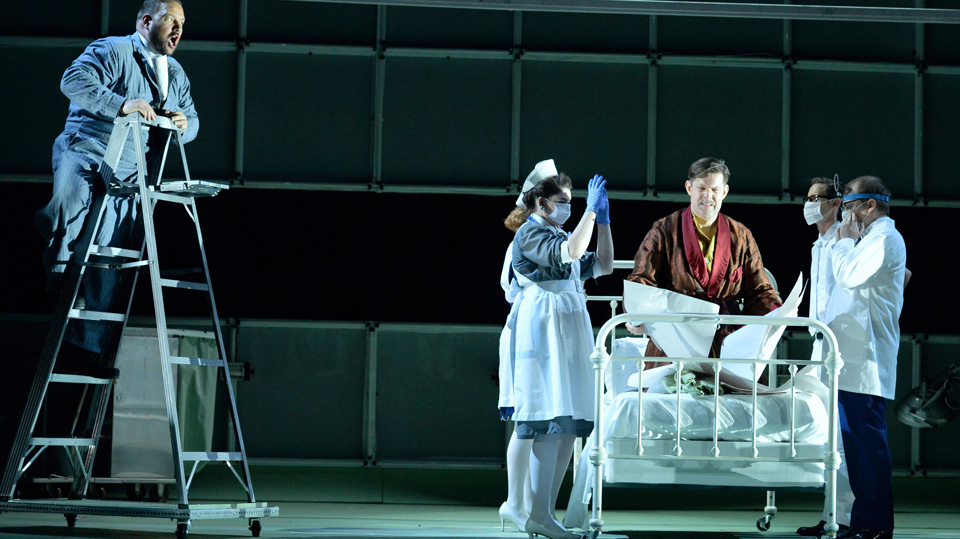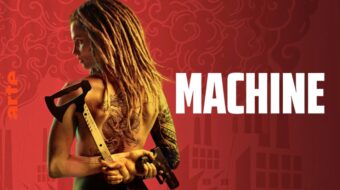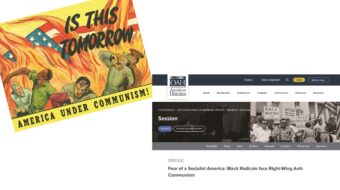
The Perfect American is no hagiography of one our country’s most beloved folklore and pop culture heroes. Based on Peter Stephan Jungk’s novel, composer Philip Glass and librettist Rudolph Wurlitzer’s ironically named opera The Perfect American takes an often scathing look at animation icon Walt Disney (baritone Justin Ryan). When thinking of “Uncle Walt,” as he was euphemistically dubbed (and marketed), color pops immediately to mind. From his classic cartoons such as 1937’s Snow White and the Seven Dwarfs to the 1960s TV series Walt Disney’s Wonderful World of Color, a richly vivid palette of hues has long been associated with this pioneer of motion picture cartoons and theme parks.
But director Kevin Newbury and scenic designer Zane Pihlstrom’s set literally appears to be in black and white—even though this a live production. Indeed, the opera takes place in the hospital where Disney, a longtime heavy smoker, spent the final three months of his life dying of lung cancer in 1966. So while whimsy and fantasy are oft-associated with the producer of 1940’s Fantasia (for my money, Disney’s greatest movie masterpiece, with its wedding of music and image), Perfect presents a starkly imperfect, grim picture of Uncle Walt. Long Beach Opera (LBO) presented the U.S. premiere of The Perfect American on March 12 and 18 at The Terrace Theater, Long Beach.
During his last days, Disney drifts between reality and illusion, as memories flow by on the stream of his consciousness, accompanied by Glass’ frequently melodious minimalist score. On the one hand, Disney was a visionary, while on the other he was a deeply conservative man, whose psyche was deeply rooted in Marceline, Mo., where he grew up. His vision of small-town U.S.A. was derived from this rural outpost, which he faithfully replicated and recreated at Disneyland’s Main Street. How odd that a man known for his visual flights of fancy came from the “Show Me State,” so called because of Missourians’ reliance on empiricism and practicality.
Theft of intellectual property
In any case, Disney was full of contradictions: Hailed as a guru by the emerging counterculture, he disdained, as Perfect’s lyrics note, hippies and mind expanding drugs, even though his cinema was often psychedelic. Although his top recurring cartoon characters—Mickey, Minnie and Goofy—were quite literally black, during Walt’s tenure at the helm of his animation empire, its only full-time African American employee was a shoeshine man. And according to Marc Eliot’s Walt Disney: Hollywood’s Dark Prince, “in his lifetime no female studio employee ever reached the executive level.”
As the opera reveals, Disney was viciously anti-communist and anti-union. The composite character Wilhelm Dantine’s (Scott Ramsay) name has, by design—according to Jungk in a pre-show talk with conductor Andreas Mitisek—the same initials as the protagonist. Dantine is identified as a leftwing draftsman fired by Disney for his militancy and pro-union stance. As Disney’s nemesis, Dantine is the opera’s conscience, denouncing the supposedly virtuoso artiste, declaring to Disney: “All you are is a moderately successful CEO,” who, he implies, is guilty of theft of intellectual property—not only the work of his animators but of “thousands of books” (while this isn’t to my knowledge true of Fantasia). Disney—the man and the studio—endlessly adapted fairy tales, historical characters and the like, instead of creating original source material.
Consider Snow White, Pinocchio and even the corporation’s latest blockbuster, Beauty and the Beast, derived from a 1740 fairy tale written down by French novelist Gabrielle-Suzanne Barbot de Villeneuve, which in turn was influenced by sources dating back to the 2nd century CE. Not content with this literary sleight of hand, now Disney has adapted its own animated feature into a live action movie, repurposing the same content into another medium.
This is the Disney M.O., aided and abetted by historically ignorant reviewers: If I hear another critic refer to the 1991 cartoon as the “original” film version of Beauty and the Beast, I’ll go Donald Duck on them, as Jean Cocteau rendered a splendid cinematic feast for the eyes while Walt was still very much alive, in 1946. And despite Disney’s ceaseless ripping off of preexisting characters such as Maui the Demigod in Moana and of actual historic figures such as Pocahontas, the corporation is famously ruthless when it comes to copyright infringement of “their” creations.
Dantine is not the only one who questions Disney’s creative (or lack of) process: A child dying in the same hospital ward (Iran-born coloratura soprano Rana Ebrahimi has a double role as Lucy and Josh) innocently asks Walt how it was possible for him to draw the millions of images necessary to create feature-length cartoons. Disney’s explanation indicates that his role was as a sort of studio supervisor, mentor and executive producer.
A friendly cooperative witness
Indeed, Dantine paints Disney as a veritable overseer of a studio plantation. Based on Disney’s testimony to the House Un-American Activities Committee on October 24, 1947, Dantine seems to at least partially be based on Conference of Studio Unions chief Herb Sorrell and David Hilberman, a labor militant who Disney told HUAC was “one artist in my plant” since 1938 who “had no religion and…had spent considerable time at the Moscow Art Theatre studying art direction, or something.” Uncle Walt also told the witch-hunters: “I believe he is a Communist.”
As the Hollywood Blacklist dawned, Disney was a “friendly” or “cooperative witness” who collaborated with HUAC’s reds-under-the-beds grand inquisitors. So the man who invented Mickey Mouse was a rat fink. It took one rodent to know one.
The 70th anniversary of Disney’s anti-communist testimony as an informer is coming up in October. An observation of the 70th anniversary of the HUAC auto-da-fé is scheduled to take place October 27, 2017, at the Writers Guild of America’s Beverly Hills theater, 70 years to the day after the first of the Hollywood Ten (former Guild President John Howard Lawson) and other “unfriendly witnesses” took the stand during the Hollywood inquisition Disney and others rolled out the red carpet for (so to speak).
According to Gerald Horne’s Class Struggle in Hollywood Disney was vice president of the rightwing Motion Picture Alliance for the Preservation of American Ideals, which included other Tinseltown reactionaries, such as Ayn “Virtues of Selfishness” Rand and John “Chicken Hawk” Wayne. In Horne’s superb book he also notes that in 1937 “Disney visited Italy and was entertained by Mussolini himself in his private villa” and that Uncle Walt “wined and dined Leni Riefenstahl [director of the 1935 pro-Hitler propaganda “doc” Triumph of the Will] during the Nazi-era filmmaker’s U.S. tour.”
While this opera does not specifically mention Disney’s HUAC testimony or, as I recall, Walt’s trysts with Benito or Leni, it does go into the cartoonist’s conservatism, anti-communism, anti-unionism, and the post-war strike that rocked Disney’s studio in 1946. (You can read the transcript of Disney’s appearance before HUAC here and watch/hear Disney denounce “commies” like the League of Women Voters (!) and “un-Americans” at this site.
Novelist Peter Stephan Jungk’s father was a Berlin-born anti-fascist Jewish journalist who went on to write much against nuclear weapons and to run as the Green Party’s presidential candidate in Austria in 1992. In 1986 the futurologist was awarded a Right Livelihood Award—a humanitarian accolade called the “Alternative Nobel Prize.” Spending part of his childhood in Southern California, Jungk was exposed to the German and other European émigrés who formed the “Strangers in Paradise” coterie of anti-Nazi exiles (including luminaries such as Bertolt Brecht, Hanns Eisler and Thomas Mann) who’d fled Hitler and settled in the L.A. area. Partially growing up in Walt’s backyard, Jungk was also impacted by Disney.
In any case, Perfect seems to bring a progressive perspective to bear on this onetime childhood hero. During the pre-opera talk Jungk said the opera’s highlight for him was the political debate between Walt and an animatronics Lincoln (as the singer for Lincoln, Jason Switzer was indisposed, Zeffin Quinn Hollister sang the role). It is much to Long Beach Opera’s credit that it boldly premiered for Americans this great, critical work, especially as it is located in between those Disney bastions of Anaheim and Burbank. (One thing’s for sure: Disney Concert Hall wasn’t about to present this work, nor the Los Angeles Opera housed across the street.)
Glass’ repetitive music is often lovely and evocative, a sonic tapestry expressing Disney’s dilemmas and visions. As with the far more colorful, Egyptian-themed Akhnaten (which LBO and LA Opera have both presented) and Einstein on the Beach (staged not long ago at downtown L.A.’s Dorothy Chandler Pavilion), Glass creatively pushes opera in new directions, much as Walt is credited with doing for animation. The 30-plus piece orchestra was ably conducted by Mitisek, the score beautifully enhanced by the Bob Cole Conservatory Chamber Choir from California State University, Long Beach.
As part of the “Ten Films That Shook the World” series celebrating the Russian Revolution’s centennial film historian/reviewer Ed Rampell is co-presenting Sergei Eisenstein’s revolutionary classic Battleship Potemkin on Fri., March 24 at 7:30 pm at The L.A. Workers Center, 1251 S. St. Andrews Place, Los Angeles 90019. For info: laworkersedsoc@gmail.com.
Rampell is scheduled to discuss Potemkin on Jerry Quickley’s program “This Is Happening” between 4-5 pm, March 22, on 90.7 FM, KPFK.

MOST POPULAR TODAY

Hold the communism, please: SFMOMA’s Diego Rivera exhibit downplays artist’s radical politics

‘Warning! This product supports genocide’: Michigan group aims to educate consumers

After months of denial, U.S. admits to running Ukraine biolabs

“Trail of Tears Walk” commemorates Native Americans’ forced removal







Comments